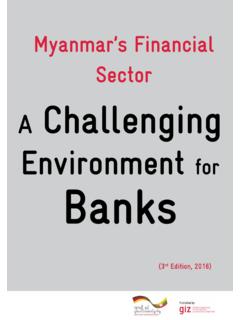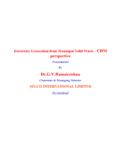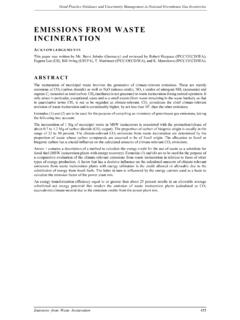Transcription of Waste-to-Energy Options in Municipal Solid Waste …
1 A Guide for Decision Makers in Developing and Emerging Countries Waste -to- energy Options in Municipal Solid Waste Management 2 As a federally owned enterprise, GIZ supports the German Government in achieving its objectives in the field of international cooperation for sustainable by:Deutsche Gesellschaft f r Internationale Zusammenarbeit (GIZ) GmbHRegistered officesBonn and Eschborn, GermanyFriedrich-Ebert-Allee 36 + 4053113 Bonn, Germany T +49 228 44 60 - 0F +49 228 44 60 - 17 66E description:Advisory Project: Concepts for Sustainable Solid Waste Management and Circular EconomyAuthors:Dieter Mutz, Dirk Hengevoss, Christoph Hugi, Thomas Gross from the University of Applied Sciences and Arts Northwestern Switzerland (FHNW).
2 Edited by: Daniel Hinchliffe, Johannes Frommann and Ellen Gunsilius from :Jeanette Geppert pixelundpunkt kommunikation, FrankfurtPhoto credits/sources: Doosan Lentjes GmbH: p. 8 and cover, 21, 24; Fachverband BIOGAS : p. 7, 30, 31, 33; Geocycle: p. 9 and cover, 26, 28; GIZ: p. 6 and cover, 10, 13, 35; Dieter Mutz: p. 11, 17, 38; Johannes Frommann: 33 (left) and links:This publication contains links to external websites. Responsibility for the content of the listed external sites always lies with their respective publishers.
3 When the links to these sites were first posted, GIZ checked the third-party content to establish whether it could give rise to civil or criminal liability. However, the constant review of the links to external sites cannot reasonably be expected without concrete indication of a violation of rights. If GIZ itself becomes aware or is notified by a third party that an external site it has provided a link to gives rise to civil or criminal liability, it will remove the link to this site immediately. GIZ expressly dissociates itself from such content.
4 GIZ is responsible for the content of this , May 2017 3 A Guide for Decision Makers in Developing and Emerging Countries Waste -to- energy Options in Municipal Solid Waste Management 4 List of Abbreviations 5 Executive Summary 61 Introduction 10 Urbanization and New Challenges in Waste Management 11 Waste -to- energy : a Temptation for Municipalities 12 Waste -to- energy and the Circular Economy 13 Myths around Waste -to- energy 152 Pre-conditions for Waste -to- energy 16 Characteristics of Municipal Waste 16 Legal Framework and Environmental Impacts 17 Financial and Institutional Aspects of WtE Plants 183 Waste -to- energy Technology Options 19 Municipal Solid Waste Incineration 20 Co-processing 26 Anaerobic Digestion for Biogas Production 30 Capturing of Landfill Gas 35
5 Alternative Technologies: Pyrolysis and Gasification 364 Decision Making Support Matrix 42 Objective 42 Decision maker s matrix 44 Recommendations 48 Annex A: Description of the decision matrix parameters 50 Annex B: Further Reading 55 References 57 TABLE OF CONTENTS5 List of Abbreviations AD Anaerobic digestion AT Alternative Technologies (Pyrolysis/Gasification) AFR Alternative Fuel and Raw materials CDM Clean Development Mechanism CH4 Methane CHP Combined Heat and Power CO Carbon Monoxide CO2 Carbon Dioxide CWG Collaborative Working Group HCl Hydrogen Chloride HF Hydrogen Fluoride LCV Lower Calorific Value LFG Landfill Gas MBT Mechanical Biological Treatment MSW Municipal Solid Waste MSWI Municipal Solid Waste Incineration MSWM Municipal Solid Waste Management NAMA Nationally Appropriate Mitigation Actions NGO Non-Government Organizations NOx Nitrogen Oxides OLR Organic
6 Loading rate O&M Operations and Maintenance PET Polyethylene terephthalate PVC Polyvinyl Chloride RDF Refuse derived fuel SDG Sustainable Development Goal SO2 Sulphur Dioxide SLF Sanitary Landfilling SRF Solid Recovery Fuel SWM Solid Waste Management WBCSD World Business Council for Sustainable Development WtE Waste -to-Energy6 EXECUTIVE SUMMARYThe tremendous rise in Municipal Solid Waste (MSW) in the fast-growing cities of developing and emerging countries have led to increasing public concerns with regards to the resultant health and environmental impacts.
7 Today, the Waste of about 3 billion people is still disposed of in an un-controlled manner [1]. As citizens and decision makers become more sensitive to environmental pollution and its impact on their quality of life, Municipal Solid Waste management (MSWM) is gaining importance on the local political agenda. In the quest to modernise their Waste manage-ment systems, local decision makers frequently face the question of whether they should invest in Waste -to- energy (WtE) technologies. WtE technologies are increasingly presented as an attractive option to solve not only the pressing Waste disposal problems but several other challenges simulta-neously: shortages in power generation, limited space for landfills, and greenhouse gas emissions from inappropriate Waste disposal.
8 However, the introduction of WtE technologies is often jeopard-ized by common obstacles such as missing tariff systems to fund investments and operation costs, weak enforcement of environmental laws and limited qualified staff to run the installed systems in an efficient and effective manner. If such aspects are not taken into account, WtE projects risk failing at the cost of the municipality and local this Guide?The Waste -to- energy discussion can be difficult to follow due to the high complexity of the different technologies, and indeed WtE is sometimes advertised as a silver bullet to solve all of a municipality s Waste and energy problems.
9 However, framework conditions in most developing and emerging countries are essentially different to those that have seen the rise of WtE projects in industrialised countries, where utility size Waste to energy plants are increasingly common. Even though from a technological point of view almost anything is possible, it does not follow that every technology can be made to fit local conditions. The bigger picture must be taken into account to decide upon the applicability and the suitability in a given context. Advice must go beyond mere technical Options in Muncipal Solid Waste Management - A Guide for Decision Makers in Developing and Emerging Countries outlines the different WtE technologies currently applied at the Municipal level and their potential role in an integrated Waste management system.
10 This Guide seeks to assist decision makers and their advisors in assessing the opportunities, limits and risks of the various WtE technologies for effective planning and efficient investments in Waste management. It aims to 1) make the present discussion on WtE more transparent, 2) provide a technical, finan-cial, institutional, social, environmental and legal overview of the most often applied WtE technol-ogies, and 3) highlight the implications and boundaries for their application while considering in-ternationally recognized environmental standards.












